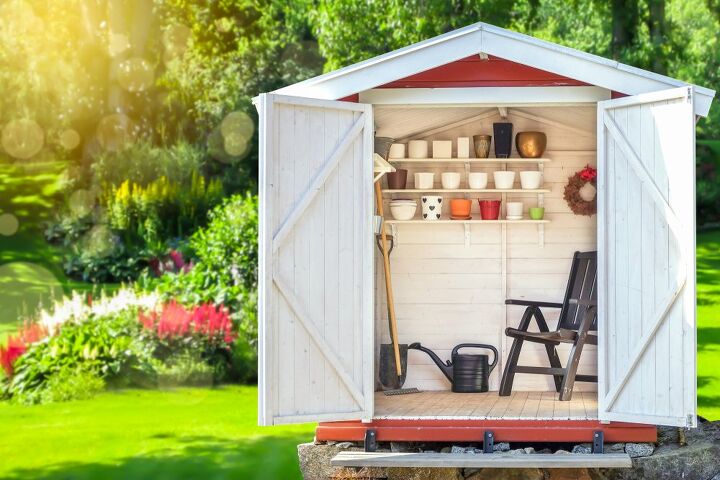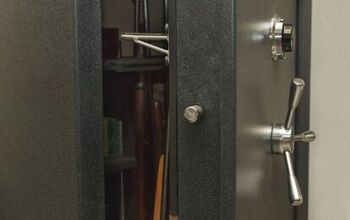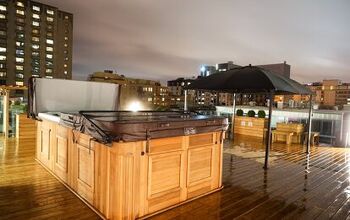Can You Put A Shed On Paving Slabs? (Find Out Now!)

Sheds have become backyard staples for a variety of reasons. In the shed you can store gardening tools and equipment, like trowels, shears, hoes, spades, shovels, and a lawnmower. In the shed is also where bags of mulch and other items not suitable for indoor storage can be put, like gas, pesticides, and herbicides.
But in order for the shed to serve as a first-rate backyard storage solution, it must be installed on a good foundation. There are many kinds of shed foundations, and such in part explains why a lot of individuals have questions about these foundations, including: “Can a shed be put on paving slabs?” Such is the main question this article answers.
Yes, you can put a shed on paving slabs. In fact, installing paving slabs is one of the best ways to ensure your shed has a reliable foundation. Paving slabs are easy to install, and they’re sturdy and long-lasting as well. You can install these on your own or have a professional bricklayer install the slabs for you.
Do You Need to Hire Shed Installers?
Get free, zero-commitment quotes from pro contractors near you.

Why the Shed Foundation Is Important
Before installing a shed, some individuals ponder whether or not installing a shed foundation before the main fixture is actually necessary. The simple answer here is yes, installing a shed foundation is totally necessary.
If you don’t install a shed foundation and instead put the shed on grass, eventually the structure will rot and become unstable. And this would be a real shame, considering most sheds are incredibly long-lasting if installed properly. A foundationless shed may seem fine at first, but things will go south soon enough—just give it some time.
And with so many kinds of shed foundations available now, it’s never been easier to install a reliable shed foundation, even if you’re a DIYer. Moreover, there are plenty of affordable options to choose from, which means having efficient outdoor storage will not come at a high cost.
What Are Shed Foundations Made Out Of?
Pavers
Pavers are great when they’re used to construct a shed foundation. You can buy large pavers at the local hardware store or at a big-box store like Home Depot or Lowe’s. And if you have everything ready to go before you start laying pavers, the installation can take less than two hours.
Just ensure the area is level before you start laying pavers. To level off the area, put down some gravel or some brickies sand. Once the area is level, cover it with a plastic tarp to add a layer of waterproofing.
This layer of gravel will help keep the pavers in place. After all, even if one paver starts to shift, the whole foundation could be compromised.
Once the pre-foundation has been established, you can start laying down pavers. Keep in mind that large pavers are sturdier than small pavers, so only large pavers should be used to construct a shed foundation.
Bare Earth
Even though it’s not advised, some individuals continue to install sheds on bare dirt, even though there are many downsides associated with doing so. If you put a metal shed on bare dirt, then you’ll need metal stakes or tent pegs to anchor the sides of the shed. Such a configuration is also recommended for plastic sheds.
But then there are fabric sheds that are actually designed for bare dirt, and these require anchors as well. Fabric sheds are fine when used in bare dirt, as fabric is a flexible material, whereas wood, metal, and plastic are not. And with a fabric shed, you won’t have to worry about corrosion, as fabric holds up better in bare dirt than most other materials.
Verdict
If the ground is uneven where you try to install a shed, it’s likely you won’t be able to get the panels to fit together properly, nor will the doors and windows look right. So while putting a shed on the bare ground is the cheapest and quickest option, it’s not the option you should pick if your goal is to have a long-lasting shed.
Gravel
Installing a gravel foundation is another low-cost option. Gravel will serve as an effective shed foundation, and on this you can install both small and midsize sheds. Gravel is ideal for sheds that are made of metal, plastic, wood, or fabric.
If you have all the materials necessary to construct a gravel shed foundation before you start digging, then it shouldn’t take you longer than two hours to construct a reliable gravel shed foundation. Of course, the shed’s size is mainly what determines how long shed foundation construction will take.
Procedure
To begin, you need to dig a hole that’s the same size as your shed, and it needs to be 3 to 4 inches deep. Once the hole has been constructed, pour in gravel and other crushed rocks.
As you pour, make sure the gravel is being packed down. You can step on it periodically or use something heavy to push the gravel down. Remember, the more packed-down the gravel is, the sturdier the foundation will be.
Although pegs and anchors aren’t necessary for a gravel shed foundation, you can use these tools to give the shed some extra security. You should get long anchors/pegs, as these will be able to take hold deep in the gravel.
Do You Need to Hire Shed Installers?
Get free, zero-commitment quotes from pro contractors near you.

Prefabricated Foundation
You could also purchase a prefabricated shed foundation from a manufacturer. While some add gravel to a prefabricated foundation, such is not required, as these foundations are secure on their own.
Keep in mind that a prefabricated foundation does need to be installed on a flat surface, as without a sturdy foundation the shed panels, doors, and windows all won’t fit right. Although prefabricated foundations can be altered to accommodate a slope, making an alteration is hard work that few find to be worthwhile.
If you’re going to use a prefabricated shed foundation, you should be ready to purchase some extras. For example, you may need plywood to complement the shed foundation, and this additional material will add to the total cost of the installation.

Matt loves everything DIY. He has been learning and practicing different trades since he was a kid, and he's often the first one called when a friend or family member needs a helping hand at home. Matt loves to work with wood and stone, and landscaping is by far his most favorite pastime.
More by Matthew Mountain



























